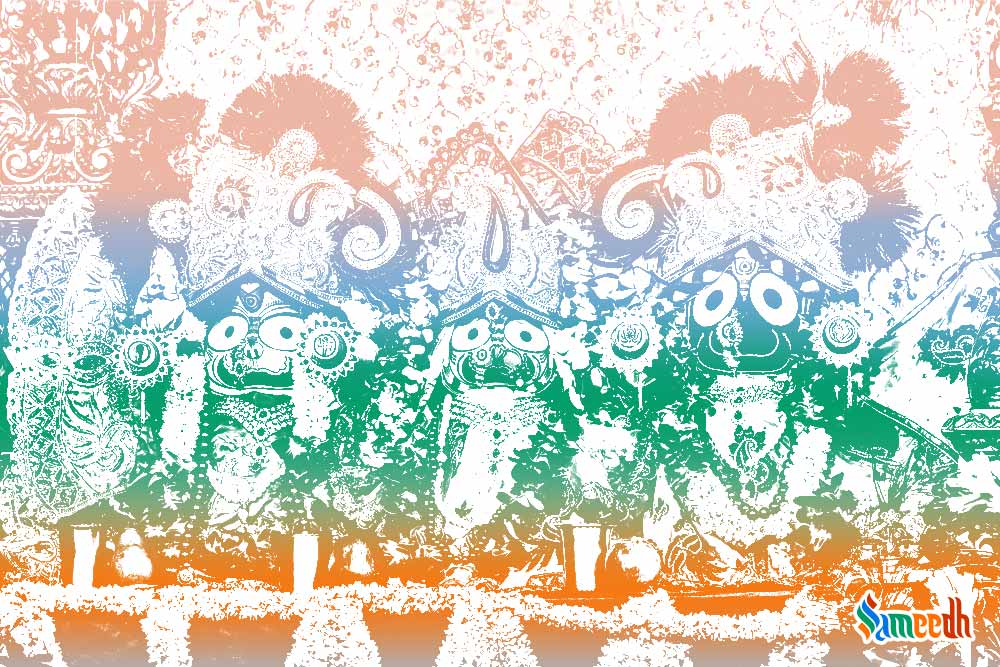Bhagwan Jagannath’s mandir situated at Puri in Odisha state of India, is a part of the ‘Chaar Dhaam’ yatra. He is worshipped along with his sister Devi Subhadra and brother Balabhadra, at the Jagannath Puri mandir.

One of the most revered Deities in India
Bhagwan Jagannath is a revered God amongst Hindu devotees. According to Odia tradition, Bhagwan Jagannath is regarded as the Para Brahma, the supreme God. He is worshipped along with his sister Devi Subhadra and brother Balabhadra, at the Jagannath Puri mandir. The Vaishnavs consider Bhagwan Jagannath to be a manifestation of Bhagwan Vishnu.
Bhagwan Jagannath Mandir at Puri, Odisha
Bhagwan Jagannath’s mandir situated at Puri in Odisha state of India, is a part of the ‘Chaar Dhaam’ yatra. As per one of the most significant stories about Bhagwan Vishnu taking the Avatar of Bhagwan Jagannath, there was a king named Indradyumna, who was a staunch believer of Bhagwan Vishnu. Once, he came to know that Bhagwan Vishnu had manifested in the form of a precious Blue gemstone known as ‘Nil Madhav’, the king wanted to possess the gem stone. In order to meet his revered deity, the king offered sahastra (1,000) ashwamedh yagya to please Bhagwan Vishnu. As he was about to offer his last ahuti (offering), a large divine log of wood appeared in the sea. It is believed that Bhagwan Vishnu appeared in Indradyumna’s dream and instructed him to carve the idols from the divine log of wood and install them in a mandir.
The architectural marvel of the magnificent Mandir
The main mandir is built in such a manner that it never casts a shadow on the ground during any part of the day. Eight metals, or ashta dhatu, are used to create the Nil-chakra, also known as the blue wheel, which is placed atop the mandir. It is said that seeing the Nil-chakra is equivalent to witnessing the Lord himself. The flag of the mandir flows in the opposite direction of the wind. A family appointed by the King is in charge of changing the flag every day after sunset. They have been performing this ceremony for more than 800 years now. The carvings on the mandirs are primarily of gods and goddesses, unlike other mandirs in the area. The Kuruma Bheda (Inner wall) and the Meghnad Pachira, two concentric walls, surround the entire mandir complex. With three more entrances along the cardinal points, the Singhdwaar on the mandir’s eastern side serves as the primary entrance. The Mahaprasad offered at the mandir is placed in the earthen pots and then placed in a stack to cook. Miraculously, the pots at the top get cooked first rather than the ones which are placed just above the fire.
The mandir witnessed numerous invasions
The Jagannath mandir is known across the globe for its glory and magnificence. Hence, it was always a target for the invaders. Many rulers have plundered the mandir. The mandir was attacked and looted because it possessed a great amount of wealth. The idols of Bhagwan Jagannath, Balabhadra, and Subhadra idols were shifted to different locations in an effort to protect them from these attacks.
Significance of the majestic Rath Yatra
The Rath yatra festival begins on the Shukla paksh Dwitiya tithi of the Hindu month Ashadh. The celebration is considered to have begun when Bhagwan Jagannath’s sister Subhadra, expressed a desire to travel to Puri. Bhagwan Jagannath, His brother Balabhadra, and Subhadra all proceeded for Puri in a chariot to fulfill Subhadra’s wish. Since then, the Jagannath festival has been celebrated annually according to the Hindu calendar. Bhagwan Jagannath and His siblings depart in their chariot during the celebration to visit the Gundicha Mandir. Here, they spend eight days at the Gundicha Mandir. The deities depart from the Gundicha Mandir and return to the Jagannath mandir on the ninth day, which is known as Bahuda Yatra.